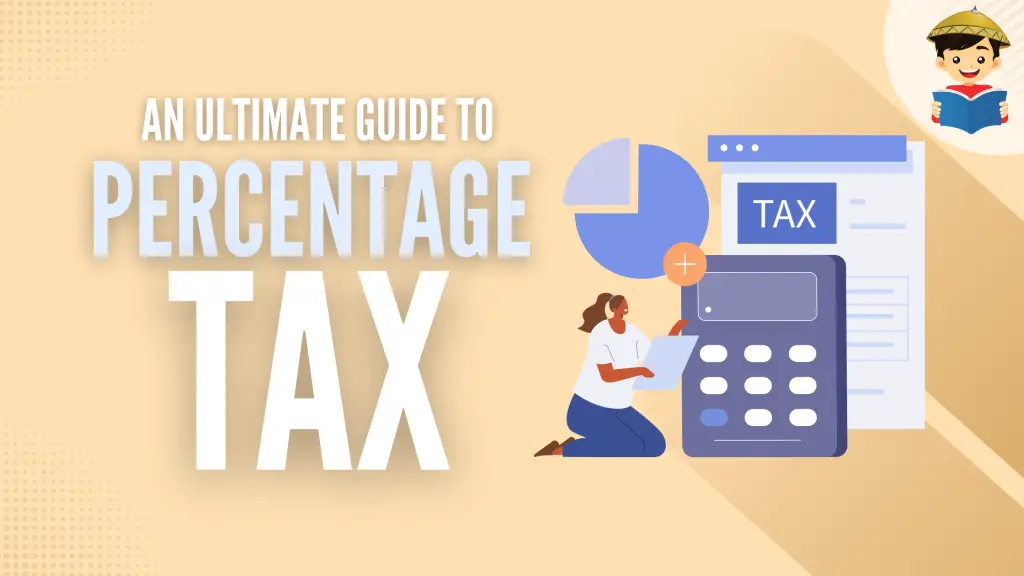How To Compute and File Percentage Tax in the Philippines: An Ultimate Guide

Aside from the taxes that we pay for our income, businesses in the Philippines are also required to pay taxes in relation to their business transactions. These are commonly known as sales taxes, and one of those taxes is percentage tax.
In this article, we will walk you through the ins and outs of the percentage tax, who are required to file it, any recent and relevant updates, and tips on how to navigate this tax type.
Table of Contents
- What Is Percentage Tax?
- What Is the Difference Between Percentage Tax and Value-Added Tax?
- What Are the Different Kinds of Percentage Tax?
- Who Is Required To File for Percentage Tax Under Bir 2551Q?
- What Is the CREATE Act and How Does It Affect Percentage Tax?
- What Are the Requirements for Filing Percentage Tax Under 2551Q?
- How To File Percentage Tax Under 2551Q
- What Is the Deadline for Filing for Percentage Tax Under 2551Q?
- Frequently Asked Questions
- 1. If I file and pay percentage tax since I am registered as a taxpayer having annual gross receipts below 3 million, and I incur more than 3 million gross receipts for the current year, when should I stop filing for Percentage Tax and start filing for Value-added tax?
- 2. Is Percentage Tax a deductible expense in the Philippines?
- 3. Since there is a change in percentage tax from 3% to 1% for taxpayers with gross receipts of 3 million or less due to the CREATE Act, what should I do if I already filed and paid using the 3% rate?
- 4. Can I opt for Value-Added Tax even if my gross receipts are 3 million or less?
- 5. In order to qualify for the carry-over of the overpaid percentage taxes, will the Annual Income Tax Return (ITR) for TY 2020 for taxpayers under the calendar year period or quarterly ITR for the Fiscal Year, together with the Audited Financial Statements (AFS), if any, also be amended if a return has been filed reflecting the 3% percentage taxes paid?
- 6. Are there instances where an overpayment of percentage tax may be subject to a refund in relation to the reduction of percentage tax from 3% to 1%?
- References
What Is Percentage Tax?

Percentage tax is a sales tax where the amount is computed based on gross sales, receipts, or other bases (see Percentage Tax Table for rates and basis).
For example, a non-VAT business qualified to pay a 3% percentage tax incurs net sales (total sales less discounts and allowances) amounting to ₱1,000,000. His percentage tax will then be computed as follows:
₱1,000,000 x 3% = ₱30,000
What Is the Difference Between Percentage Tax and Value-Added Tax?

Both percentage tax and value-added tax are sales taxes, which means they are a tax on the primary business activity of entities whose goal is to earn a profit. However, there are crucial differences between the two, as summarized in the table below.
| Category | Percentage Tax | Value-added Tax |
| Tax base | Percentage tax based on Net Sales/Receipts/Premiums | Output VAT (based on Net Sales) less Input VAT (based on Net Purchases) |
| Primary Forms filed | 2551Q | 2550M and 2550Q |
| Filing | Quarterly | Monthly and Quarterly |
| Other submissions required related to tax type | None | Summary list of Purchases, Summary List of Sales |
| Accounting recognition | Deductible Expense | Liability (VAT payable) or Asset (VAT credit) |
What Are the Different Kinds of Percentage Tax?

There are two general types of percentage tax according to tax forms used, namely:
1. Percentage Tax Under Sections 116 to 126 of the Tax Code
These are the most common percentage taxes filed by taxpayers since this is a periodic tax (this is filed every quarter, even if you do not have any transactions that incur percentage tax). This covers tax on sales, receipts, and other bases, and is filed quarterly using BIR Form 2551Q.
2. Percentage Tax Under Section 127 of the Tax Code
These cover percentage tax on transactions involving shares of stocks that are listed and traded through the local stock exchange or through Initial or Secondary Public Offering. These percentage taxes are transactional taxes (filed for every instance of a transaction only) and are filed using BIR Form 2552.
For this article, we will be focusing on those filed through BIR Form 2551Q.
Who Is Required To File for Percentage Tax Under Bir 2551Q?
There are a lot of percentage tax rates applicable for different transactions, so we’ve arranged the categories in the table below.
BIR usually indicates in your Certificate of Registration (BIR Form 2303) if you are to pay Percentage Tax, Value-Added Tax, or the 8% Income Tax. Check your COR just to be sure!
| Category | Alphanumeric Tax Code | Tax Basis and Rate |
| Non-VAT-registered taxpayers who: – sell goods, properties, or services – whose annual gross sales and/or receipts do not exceed ₱3,000,000 – are exempt from VAT – did not opt for the 8% income tax rate on Gross Sales/Receipts over ₱250,000 | PT 010 | 3% of Gross Sales or Receipts (regular rate) 1% of Gross Sales or Receipts from July 1, 2020, until June 30, 2023 |
| Lessors of residential units with a monthly rental per unit exceeding ₱15,000, (except if the annual rentals of the lessor during the year exceed ₱3,000,000) | PT 010 | 3% of Gross Receipts |
| Domestic carriers by land for the transport of passengers (except owners of bancas and owners of animal-drawn two-wheeled vehicles) and keepers of garages | PT 040 | 3% of Gross Receipts |
| International air and shipping carriers doing business in the Philippines on their gross receipts derived from the transport of cargo from the Philippines to another country | PT 041 | 3% of Gross Receipts |
| Franchise grantees of radio and/or television broadcasting companies whose annual gross receipts for the preceding year do not exceed ₱10,000,000.00 and did not opt to register as VAT taxpayers | PT 060 | 3% of Gross Receipts |
| Franchise grantees of gas and water utilities | PT 060 | 2% of Gross Receipts |
| Overseas dispatch, message or conversation transmitted from the Philippines by telephone, telegraph, tele-writer exchange, wireless, and other communication equipment services | PT 090 | 10% of Gross Receipts |
Applicable for banks, non-bank financial intermediaries performing quasi-banking functions:
| Category | Alphanumeric Tax Code | Tax Basis and Rate |
| Interest, commissions, and discounts from lending activities, as well as income from financial leasing | PT 105 – If the maturity period is five years or less PT 101 – If the maturity period is more than five years | 5% of Interest, Commission, Discounting, or Finance Lease Income 1% of Interest, Commission, Discounting, or Finance Lease Income |
| Dividends and equity shares and net income of subsidiaries | PT 102 | 0% |
| Royalties, rentals of property, real or personal, profits from the exchange, and all other items treated as gross income | PT 103 | 7% of Gross Receipts |
| Net trading gains within the taxable year of foreign currency, debt securities, derivatives, and other similar financial instruments | PT 104 | 7% of Gains |
Applicable for other non-bank financial intermediaries including pawnshops1 :
| Category | Alphanumeric Tax Code | Tax Basis and Rate |
| Interest, commissions, discounts from lending activities, as well as income from financial leasing | PT 113 – If the maturity period is more than five years PT 114 – If the maturity period is more than five years | 5% of Interest, Commission, Discounting, or other Gross Income items 1% of Interest, Commission, Discounting, or other Gross Income items |
| Interest, commissions, discounts, and all other items treated as gross income | PT 115 | 5% of Interest, Commission, Discounting, or other Gross Income items |
Applicable for insurance companies:
| Category | Alphanumeric Tax Code | Tax Basis and Rate |
| Person, company, or corporation (except purely cooperative companies or associations) doing life insurance business in the Philippines | PT 120 | 2% of premiums collected |
| Fire, marine, or miscellaneous agents of foreign insurance companies | PT 130 – Authorized insurance agents PT 132 – Owners of property obtaining insurance directly with foreign insurance companies | 4% of premiums collected 5% of premiums collected |
Applicable for amusement companies:
| Category | Alphanumeric Tax Code | Tax Basis and Rate |
| Proprietor, lessee, or operator of cockpits, cabarets, night or day clubs, videoke bars, karaoke bars, karaoke televisions, karaoke boxes, and music lounges | PT 150 | 18% of Gross Receipts |
| Boxing exhibitions2 | PT 160 | 10% of Gross Receipts |
| Professional basketball games | PT 170 | 15% of Gross Receipts |
| Jai-alai and race track | PT 180 | 30% of Gross Receipts |
What Is the CREATE Act and How Does It Affect Percentage Tax?
Republic Act (RA) No. 11534, also known as the Corporate Recovery and Tax Incentives for Enterprises (CREATE) Act, was created in response to the COVID-19 pandemic as a financial relief to corporations doing business in the Philippines. It amends several provisions in the old Tax Code with a central focus on lowering tax rates.
For Percentage Tax, the act reduces the rate for non-VAT taxpayers subject to percentage tax from 3% to 1% for the period from July 1, 2020 until June 30, 20233 for both individual and non-individual taxpayers4 .
What Are the Requirements for Filing Percentage Tax Under 2551Q?
The following are the requirements for filing BIR Form 2551Q:
1. Required
- BIR FORM 2551Q (January 2018 version) – This will be the tax form for filing percentage tax as discussed previously. Note that upon the implementation of TRAIN Law (RA 10963), the monthly percentage tax form 2551M was no longer required to file5. This means you will only need to file every quarter instead of every month.
2. Situational
| Requirement | You need to submit this when: |
| Duly issued Certificate of Creditable Tax Withheld at Source (BIR Form 2307) | You want to apply for Tax Credits from BIR Form 2307 as a deduction to the Percentage Tax payable for the form being applied |
| Duly approved Tax Debit Memo | You want to apply for Tax Credits from a Tax Debit Memo issued by the BIR as a deduction to the Percentage Tax payable for the form being applied |
| Proof of payment and the BIR 2551Q previously filed | You want to amend a previously-filed return |
| Authorization letter/Special Power of Attorney | You want to file the tax return through a representative or agent |
| Copy of Certificate of Registration issued by Cooperative Development Authority (CDA) for cooperatives, and from the National Electrification Administration (NEA) for electric cooperatives | You are a member of the CDA or NEA |
| Printed email of the Tax Return Receipt Confirmation | You filed through eBIRForms |
How To File Percentage Tax Under 2551Q

There are three methods for filing for Percentage Tax under 2551Q: Manual, eFPS, and eBIRForms.
1. Manual
Step 1: Get the Form
Download the BIR Form 2551Q in PDF file format HERE. Three copies are required. Ensure that this is the latest version.
Step 2: Fill up the details
Properly fill up BIR Form 2551Q in three copies. Ensure that the basic taxpayer details and transaction details are complete. Tip: To save on time and effort on writing the details of the tax return, you may print one copy of the tax form before signing it, and then have it photocopied two times (you should now have three copies). Then you should sign the three copies.
Step 3: Pay taxes
(For forms with no payment, skip to STEP 4) For this option, you have three options:
a. Proceed to any Authorized Agent Bank (AAB)6 under the Revenue District Office (RDO) where the taxpayer is registered and present the duly accomplished BIR Form 2551Q and other attachments. Present all requirements with a BIR-prescribed deposit slip and the cash/check payment to the respective AAB. Important! The BIR Form 2551Q shall be paid at the date the return is filed by the taxpayer.
b. In places where there are no AABs, the duly accomplished BIR Form 2551Q, together with the required attachments and payment, shall be filed and paid with the Revenue Collection Officer (RCO), thru the Mobile Revenue Collection Officers System facility, or duly Authorized City or Municipal Treasurer where said business or principal place of business/where the taxpayer is registered, who will issue an Electronic Revenue Official Receipt.
c. The taxpayer can pay online through GCash Mobile Payment, LandBank of the Philippines (LBP) Linkbiz Portal, or DBP Tax Online (for holders of VISA/Master Credit Card/Bancnet ATM or Debit Card). Attach the screenshot of the successful payment confirmation to the forms.
Step 4: Submit the validated form
Submit the BIR Form 2551Q to the RDO. If payment was made, a validated/stamp-received BIR Form 2551Q by the AAB/RCO/authorized City or Municipal Treasurer, or a screenshot of the online payment confirmation shall be attached.
2. eFPS
Step 1: Online filing
Go to the EFPS Dashboard, select BIR Form 2551Q, and click File Tax Return. Select applicable alphanumeric tax codes (ATCs) for your transactions. The taxable amount to be indicated in the quarterly percentage return shall be the total gross sales/receipts for the quarter. Do not forget to validate the form before submission.
Step 2: Pay taxes online
After filing, proceed to online payment by clicking the Proceed to Payment button and pay the quarterly percentage tax due. The link will then redirect to the linked Online Banking facility of the taxpayer to confirm the payment.
3. eBIRForms
Step 1: Online filing
Open the eBIRForms program (ensure that you have the latest version by checking here), and select BIR 2551Qv2018 (the latest version at the time of writing). Select applicable alphanumeric tax codes (ATCs) for your transactions. The taxable amount to be indicated in the quarterly percentage return shall be the total gross sales/receipts for the quarter. Do not forget to validate the form before submission.
Step 2: Print the forms and attachments
Print three copies of the BIR 2551Q along with a copy of Tax Return Receipt Confirmation sent through the taxpayer’s email. Attach any applicable attachment as well.
Step 3: Pay taxes
(For forms with no payment, you no longer have to do this step) For eBIRForms, you have three options:
a. Proceed to any Authorized Agent Bank (AAB) under the Revenue District Office (RDO) where the taxpayer is registered and present the printed BIR Form 2551Q and other attachments. Present all requirements with a BIR-prescribed deposit slip and the cash/check payment to the respective AAB. Important! The BIR Form 2551Q shall be paid at the date the return is filed by the taxpayer.
b. In places where there are no AABs, the duly accomplished BIR Form 2551Q, together with the required attachments and payment, shall be filed and paid with the Revenue Collection Officer (RCO), thru the Mobile Revenue Collection Officers System facility, or duly Authorized City or Municipal Treasurer where said business or principal place of business/where the taxpayer is registered, who will issue an Electronic Revenue Official Receipt.
c. The taxpayer can pay online through GCash Mobile Payment, LandBank of the Philippines (LBP) Linkbiz Portal, or DBP Tax Online (for holders of VISA/Master Credit Card/Bancnet ATM or Debit Card). Attach the successful screenshot of the payment confirmation to the forms.
What Is the Deadline for Filing for Percentage Tax Under 2551Q?
The form must be filed twenty-five (25) days after the end of each taxable quarter. Refer to the following table for the schedule of all four quarters:
| Quarter | Deadline |
| 1st | April 25 |
| 2nd | July 25 |
| 3rd | October 25 |
| 4th | January 25 |
Noncompliance with the deadlines and nonpayment are subject to the BIR’s standard penalties7.
Frequently Asked Questions
1. If I file and pay percentage tax since I am registered as a taxpayer having annual gross receipts below 3 million, and I incur more than 3 million gross receipts for the current year, when should I stop filing for Percentage Tax and start filing for Value-added tax?
You should file for Value-Added Tax for the year following the year you incurred 3 million pesos gross receipts. For example, if you incurred more than 3 million gross receipts in 2021, you must start filing and paying VAT starting January 2022. Furthermore, you must submit a duly-accomplished BIR Form 1905 (Information Update), BIR 1906 (Authority to Print), and BIR 2303 Certificate of Registration. Your existing invoice and receipts will be replaced as well (to reflect their change from non-VAT to VAT).
2. Is Percentage Tax a deductible expense in the Philippines?
Yes, if the taxpayer is paying income tax under the Itemized Deductions option. Percentage taxes is an additional expense to the taxpayer and is not fully passed on to the customer, unlike VAT. This is not applicable, however, if the taxpayer opts for the OSD.
3. Since there is a change in percentage tax from 3% to 1% for taxpayers with gross receipts of 3 million or less due to the CREATE Act, what should I do if I already filed and paid using the 3% rate?
You must amend the previously filed returns which are under the CREATE Act’s date coverage but were filed using a 3% rate. So, any BIR Form 2551Q filed using a 3% rate shall be amended to affect the 1% rate.
Do not forget to include payments made for the previously filed return in item 16. Excess percentage tax payments as a result of the decrease of tax rate starting July 1, 2020, until the effectivity of the reduced rate may be carried forward to the succeeding taxable quarters. This carry-over portion is intended for the Percentage Taxpayers who are regularly filing the returns and are expected to have overpaid taxes as a result of the retroactive application of the CREATE8 .
4. Can I opt for Value-Added Tax even if my gross receipts are 3 million or less?
Yes, the taxpayer can select VAT even if their gross receipts do not exceed 3 million. This is recommended for taxpayers who are expecting to scale their business immediately and expect that their gross sales will easily breach the 3 million requirement, and would like to save time in filing an amendment should they qualify for VAT. Take note that all taxpayers are mandated to be classified as VAT once they exceed 3 million.
5. In order to qualify for the carry-over of the overpaid percentage taxes, will the Annual Income Tax Return (ITR) for TY 2020 for taxpayers under the calendar year period or quarterly ITR for the Fiscal Year, together with the Audited Financial Statements (AFS), if any, also be amended if a return has been filed reflecting the 3% percentage taxes paid?
Only the ITRs filed are needed to be amended without necessarily amending the corresponding AFS. However, if the AFS will not be amended, the overpaid percentage tax shall be reflected as a reconciling item in the amended ITRs (BIR, 2021).
6. Are there instances where an overpayment of percentage tax may be subject to a refund in relation to the reduction of percentage tax from 3% to 1%?
If the taxpayer shifted from non-VAT to VAT-registered status or if the taxpayer has opted to avail of the eight percent (8%) income tax rate at the beginning of 2021, the overpayment as a result of the reduction of tax rates for July to December 2020 will no longer be of other use by the taxpayer since they have already opted for a different tax type by the beginning of the next year. Hence, a tax refund may be applied.
References
- Bureau of Internal Revenue (BIR). (2004). Revenue Regulations No. 10-2004. Retrieved from https://www.bir.gov.ph/images/bir_files/old_files/pdf/14592rr04_10.pdf
- Philippine Law and Jurisprudence Databank. Republic Act No. 1812 (1957).
- Bureau of Internal Revenue (BIR). (2021). Revenue Regulations No. 4-2021. Retrieved from https://www.bir.gov.ph/images/bir_files/internal_communications_1/Full%20Text%20RR%202021/RR%20NO.%204%20-%202021.pdf
- Bureau of Internal Revenue (BIR). (2021). Revenue Regulations No. 67-2021. Retrieved from https://www.bir.gov.ph/images/bir_files/internal_communications_2/RMCs/2021%20RMCs/RMC%20No.%2067-2021.pdf
- Official Gazette. Republic Act No. 10963 (2022).
- List of Authorized Agent Banks. Retrieved 30 May 2022, from https://www.bir.gov.ph/index.php/list-of-authorized-agent-banks.html
- Penalties. Retrieved 30 May 2022, from https://www.bir.gov.ph/index.php/penalties.html
- Congress of the Philippines. (2017). Bureau of Internal Revenue (BIR). (2021). Revenue Regulations No. 8-2021. Retrieved from https://www.bir.gov.ph/images/bir_files/internal_communications_1/Full%20Text%20RR%202021/RR%20No.%208-2021.pdf
Written by Romeo Miguel Ginez, CPA
Romeo Miguel Ginez, CPA
Romeo Miguel Ginez is a Certified Public Accountant who has helped different companies and individuals with their accounting and tax-related concerns since 2014. He currently runs an accounting firm that advocates automation and cloud-based accounting for SMEs. He is also an educator, and a gamer, and has a passion to debate important topics. To contact Romeo, send an email to [email protected], or reach out to his mobile number 09176529792 through SMS, Viber, or WhatsApp.
Copyright Notice
All materials contained on this site are protected by the Republic of the Philippines copyright law and may not be reproduced, distributed, transmitted, displayed, published, or broadcast without the prior written permission of filipiknow.net or in the case of third party materials, the owner of that content. You may not alter or remove any trademark, copyright, or other notice from copies of the content. Be warned that we have already reported and helped terminate several websites and YouTube channels for blatantly stealing our content. If you wish to use filipiknow.net content for commercial purposes, such as for content syndication, etc., please contact us at legal(at)filipiknow(dot)net